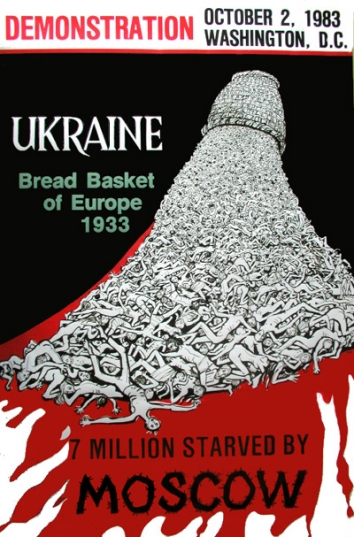Featured Galleries USUBC COLLECTION OF OVER 160 UKRAINE HISTORIC NEWS PHOTOGRAPHS 1918-1997
 Holodomor Posters
Holodomor Posters

Biopharma M&A soars in 2015: Is this the new normal?
 EY, Kyiv, Ukraine
EY, Kyiv, Ukraine
Tue, March, 29, 2016
Biopharma M&A soars in 2015: Is this the new normal?
- Record M&A value over US$300b reflects industry transformation
- Growth targets, consolidation and health care costs top industry’s 2016 agenda
- Biotech appetite for M&A rising while firepower reaches new high
- Specialty pharma companies see ability to pursue large acquisitions depleted
SAN FRANCISCO, KYIV, 29 March 2016. Mergers and acquisitions (M&A) in the biopharmaceutical industry skyrocketed in 2015, with the value of 2015 announced deals totalling more than US$300b, a new record for the industry, according to EY’s Firepower Index and Growth Gap Report 2016. Much of this activity was driven by companies seeking to create more focused businesses and close persistent revenue “growth gaps".[1] The previous industry M&A record was set in 2014 exceeding US$200b in aggregate value.
In 2016, a renewed focus on value-based drug pricing, staunch competition across key therapeutic battlegrounds and consolidated payer clout may exacerbate existing growth gaps, resulting in a continued feverish deal environment for this year and beyond.
The EY Firepower Index measures biopharma companies' ability to fund M&A transactions based on the strength of their balance sheets and their market capitalization. Thus, a company's firepower increases when either its market capitalization or its cash and equivalents rise – or its debt falls.
Glen Giovannetti, EY’s Global Life Sciences Leader, says:
“While we can’t predict more large transformational deals over US$100b in 2016, we do expect a continued brisk pace for acquisitions and a continuation of the robust divestiture environment, as companies seek to focus on and gain scale in their chosen therapeutic areas. Three times as many companies now possess at least US$3b in firepower than a year ago, meaning more competition for targets as well as a longer list of potential acquirers for divestitures. Big pharma, in particular, should capitalize on its dominant share of firepower and continue to pursue aggressive but strategically sound deals to fill its portfolio and pipeline gaps.”
Although big pharma is starting to see growth through R&D successes in areas such as oncology and infectious disease, many of the industry's biggest players will continue to turn to M&A to reach their growth goals, with focused acquisitions and divestitures becoming paramount.
Key findings highlighted in this year’s report include:
- M&A: specialty pharma leads, big pharma follows, while biotech ambitions rise: Early 2015 deal activity was driven by specialty pharma companies with a majority of deals by total valuation in the specialty or generics sector. But big pharma grabbed the limelight later in the year while biotech was marked more by modest deals but with bolder ambitions for 2016.
- Growth gap persists: Big pharma’s aggregate growth gap – the revenue shortfall below global biopharmaceutical sales growth – remained stuck at near US$100b due in part to foreign exchange headwinds. In 2016, there was only one deal that will have a significant impact on big pharma's growth gap.
- Specialty pharma’s firepower drops while biotech rises to new highs: Following a recent series of debt-fuelled acquisitions and falling equity valuations, specialty pharma’s firepower, has decreased by nearly 50%. Simultaneously, big biotech’s firepower has reached new highs of more than US$300b.
Implications for 2016
While biopharma companies continue to benefit from an era of increased drug approvals and healthy pipelines, the report identifies several industry challenges and considerations likely to drive M&A in 2016 and beyond:
- Payer consolidation may drive M&A: Major payer mergers and continued consolidation among pharmacy benefit managers are bringing greater negotiating clout. As a result, biopharma firms may face new sales growth challenges necessitating M&A by deploying their firepower to close growth gaps.
- Divestitures likely to continue: Divestitures now account for about 25% of aggregate M&A value. As 2015 wound down, divesting companies generated more firepower than their non-divesting counterparts and generated greater total shareholder returns for investors. As portfolios continue to transform, divestitures should continue to account for around 25% of M&A in 2016.
- Biotechs to start dealing: Payer pressure and competition in therapeutic battlegrounds will increase the likelihood of biotech M&A exceeding 2015’s US$25b outlay. Moreover, big biotech’s firepower reached record value and market share in 2015, supporting a robust deal outlook for 2016.
Jeffrey Greene, EY’s Global Life Sciences Transaction Advisory Services Leader, says: “The drivers of industry M&A in 2015, including payer consolidation, rising health care costs and companies’ growth imperatives, are only intensifying. These pressures may make the lofty heights of US$200b in annual M&A the new normal for the foreseeable future. We expect deals targeting narrower therapeutic battlegrounds, geographic strongholds and portfolio rationalization to drive the 2016 M&A agenda.”
––
About the EY Firepower Index
Now in its fourth year, the EY Firepower Index measures companies’ capacity to fund transactions based on the strength of their balance sheets. It has four key inputs: 1. Cash and equivalents; 2. Existing debt; 3. Debt capacity, including credit lines; and 4. Market capitalization. In constructing the model, the following assumptions were made: first, a company will not acquire targets that exceed 50% of its existing market capitalization; second, the debt/equity ratio of the combined entity created by a transaction cannot exceed 30%.
While some pharma companies have made acquisitions that go beyond these upper limits, our intent is to apply a uniform methodology to measure relative changes in firepower. The Firepower Index measures capacity to conduct M&A transactions financed with cash or debt. It does not measure the ability to conduct stock-for-stock transactions. However, increases in a company’s stock price do boost its firepower under the EY Firepower Index’s formula. That is because equity enables companies to borrow more to finance transactions.
In our report, companies were classified as big pharma, specialty pharma/generics or big biotech based on their size, geographic reach and product portfolio. Seventeen big pharma companies were analyzed for this report, while 10 specialty pharma/generics firms and 11 big biotechs were included.
About EY’s Global Life Sciences Sector
Life sciences companies – from emerging startups to multinational enterprises – face new challenges in a rapidly changing health care ecosystem. Payers and regulators are increasing scrutiny and accelerating the transition to value and outcomes. Big data and patient-empowering technologies are driving new approaches and enabling transparency and consumerism. Players from other sectors are entering health care, making collaborations increasingly complex. These trends challenge every aspect of the life sciences business model, from R&D to marketing. Our Global Life Sciences Sector brings together a worldwide network – more than 7,000 sector-focused assurance, tax, transaction and advisory professionals – to anticipate trends, identify implications and develop points of view on responding to critical issues. We can help you navigate your way forward and achieve success in the new ecosystem.
For more timely insights on the key business issues affecting life sciences companies, please go to ey.com/VitalSigns. You can also visit ey.com/lifesciences or email global.lifesciences@ey.com for more information on our services. To connect with us on Twitter - @EY_LifeSciences.
About EY
EY is a global leader in assurance, tax, transaction and advisory services. The insights and quality services we deliver help build trust and confidence in the capital markets and in economies the world over. We develop outstanding leaders who team to deliver on our promises to all of our stakeholders. In so doing, we play a critical role in building a better working world for our people, for our clients and for our communities.
EY works together with companies across the CIS and assists them in realizing their business goals. 4,500 professionals work at 20 CIS offices (in Moscow, St. Petersburg, Novosibirsk, Ekaterinburg, Kazan, Krasnodar, Rostov-on-Don, Togliatti, Vladivostok, Yuzhno-Sakhalinsk, Almaty, Astana, Atyrau, Bishkek, Baku, Kyiv, Tashkent, Tbilisi, Yerevan, and Minsk).
EY refers to the global organization, and may refer to one or more, of the member firms of Ernst & Young Global Limited, each of which is a separate legal entity. Ernst & Young Global Limited, a UK company limited by guarantee, does not provide services to clients. For more information about our organization, please visit ey.com.
This news release has been issued by EYGM Limited, a member of the global EY organization that also does not provide any services to clients.
[1] Growth gap is defined as the difference in the projected sales growth of a biopharma company or biopharma sub-sector (e.g., big pharma) relative to overall drug market sales per IMS Health’s global drug market forecast as of October 31, 2015.











